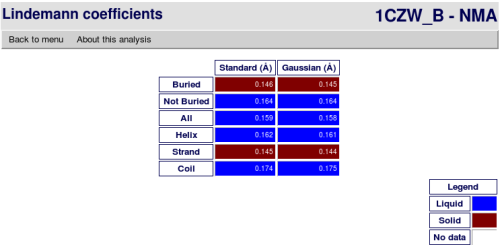This coefficient is an estimate of the solid-liquid behaviour of the protein. Values below 0.15 are considered to be solid, while values over 0.15 will be called liquids. The usual behaviour is that the residues inside the protein (the buried ones) have a lower Lindemann coefficient (are more solid-like) than the residues that remain in the surface of the protein.
This coefficient is taken from a paper by Y. Zhou, D. Vitkup and M. Karplus (1999), Native proteins are Surface-molten solids: application of the Lindemann criterion for the solid versus liquid state.
In this analysis you can observe the values for all the residues, classified according to accesibility and secondary structure.
The code color indicates if the coefficient tends to be solid (brown) or liquid (blue).
A value of zero means that no residue of that type could be identified (i. e. no strands in the protein analyzed). In that case, the code color is white.
The equations used to compute the coefficient follows:
where N is the number of atoms, a' is an empirical constant, and ri is the position of atom i.
